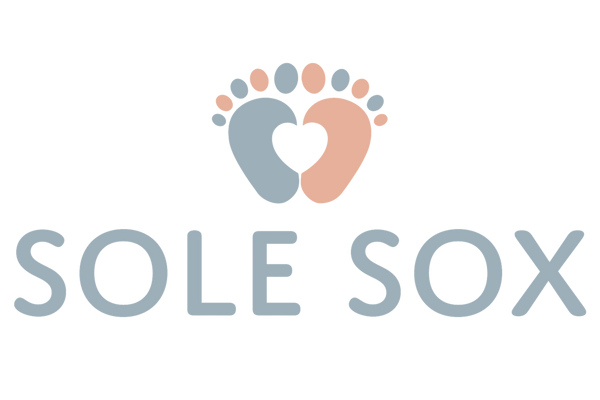Sole Sox Vs. 'Normal' Shoes

Wearing regular narrow, hard, rigid, and heavy shoes can significantly hinder a baby’s ability to learn to walk effectively. Here are several reasons why such footwear is detrimental during this crucial developmental stage:
- Restricted Foot Movement: Narrow shoes constrict the natural movement of a baby’s toes, preventing them from spreading out and flexing as they should. This restriction can lead to improper foot development and alignment issues over time .
- Impeded Balance and Coordination: Heavy and rigid shoes can interfere with a baby’s balance and coordination. Babies need to develop muscle strength and proprioception, which is the body’s ability to sense its position in space. Stiff shoes can obstruct this sensory feedback, making it harder for them to learn how to walk confidently .
- Lack of Flexibility and Comfort: Babies’ feet are still developing and require flexible shoes that allow for natural bending and movement. Rigid shoes can create discomfort, making babies less willing to practice walking and exploring their environment, which is vital for developing motor skills .
- Potential for Injury: Heavier shoes can increase the risk of trips and falls, as they alter the baby’s natural gait and balance. A safe and supportive shoe that mimics barefoot conditions allows babies to navigate their surroundings more safely .
- No Need for Arch Support: Young babies learning to walk do not require arch support, as their feet are still developing and the arches are naturally flexible. Shoes should facilitate this natural foot movement rather than impose artificial structures that can hinder growth. Providing a flat and flexible sole is more beneficial at this stage .
Narrow toe boxes in baby shoes are problematic because they restrict the natural movement of a baby’s toes, which is essential for proper foot development. Babies are born with flexible, soft bones that need space to grow and strengthen. When shoes have a tight or narrow toe box, they squeeze the toes together, leading to various issues like:
- Impaired Toe Movement: Babies use their toes for balance, grip, and stability when learning to stand, walk, and run. A narrow toe box restricts this movement, making it harder for them to develop these motor skills properly.
- Inhibition of Natural Foot Growth: The natural shape of a baby’s foot is widest at the toes. Constricting shoes can prevent toes from spreading as they naturally should, which can affect the growth and alignment of bones. This may lead to long-term issues such as hammertoes, bunions, or other deformities as the foot matures.
- Reduced Balance and Stability: The toes play a key role in maintaining balance. When they are squeezed, babies may struggle to develop the coordination needed for stable walking. Barefoot or shoes with wide toe boxes allow for better distribution of weight and support proper posture.
- Circulation Issues: Tight toe boxes can reduce blood flow to the toes, potentially leading to discomfort, poor circulation, and even colder feet.
- Muscle and Nerve Development: Babies’ feet need room to move and flex, allowing the muscles, tendons, and nerves to grow strong and functional. A restrictive toe box can impair this development, resulting in weaker foot muscles and potentially leading to flat feet or other alignment issues later in life.
For optimal foot health and development, it is essential that babies wear lightweight, flexible shoes like Sole Sox that allow for natural movement and growth, rather than traditional narrow, hard, and heavy shoes.
Wearing lightweight and flexible shoes like Sole Sox, that mimic barefoot walking is crucial for several reasons:
- Natural Foot Development: Babies’ feet are soft and malleable, consisting of cartilage that will eventually form into bones. Allowing feet to move freely helps strengthen muscles, ligaments, and tendons. Shoes that mimic barefoot walking provide just enough protection while still enabling the foot to flex and move naturally, fostering optimal growth.
- Promotes Balance and Coordination: Barefoot walking or using flexible shoes allows babies to feel the ground beneath them, improving proprioception (the awareness of their body’s position). This sensory feedback helps them develop better balance, coordination, and stability as they learn to walk. A rigid shoe can block these important sensory cues, slowing down motor skill development.
- Encourages Proper Posture: When babies walk barefoot or in flexible shoes, their toes naturally spread out, which encourages proper posture and alignment. This helps prevent issues like flat feet and encourages a natural gait. Heavier, stiff shoes can alter this natural movement, causing improper walking patterns or postural problems.
- Protects Without Hindering Movement: Lightweight, flexible shoes provide the right amount of protection from external elements like sharp objects or hot surfaces without adding unnecessary weight that might hinder a baby’s ability to move freely. They allow babies to transition smoothly from crawling to standing and walking without feeling weighed down.
- Prevents Overheating and Discomfort: Babies are sensitive to temperature changes, and lightweight, breathable shoes reduce the risk of overheating. Flexible materials also prevent the buildup of sweat and discomfort, encouraging babies to keep their shoes on.
Research consistently shows that babies benefit most from being barefoot, but when shoes are necessary, designs that mimic barefoot conditions are ideal for healthy foot and overall physical development .
Why are gumboots problematic for babies’ feet?
Click here to find out more.
